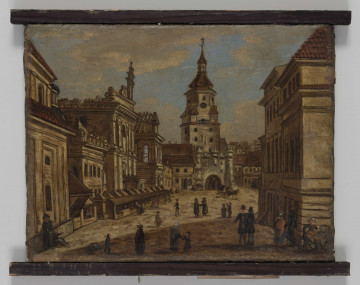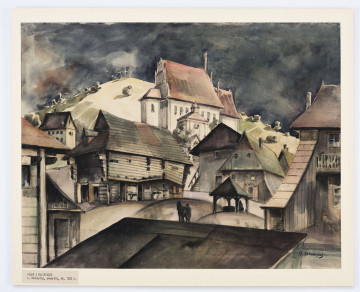
Krakow suburb
circa 1926-1939
National Museum in Lublin
Part of the collection: Polish landscape painting (19th–1st half of the 20th c.)
‘A great painter of small pictures’ – the words uttered by one of the critics accurately reflect the character of Jan Stanislawski's work. He painted nature only – landscapes in tiny formats, sometimes not more extensive than a sheet of paper. He captured the places he visited during his numerous journeys. The best paintings show views from the area of Ukraine and Malopolska. Stanislawski did not focus on faithful reproduction of selected landscape fragments; meticulous, ‘scientific’ realism was alien to him. Instead, he tried to render what was most challenging to capture on canvas – fleeting impressions, fleeting sensations and emotions, which they evoked in him. They can be treated as the artist's confession, speaking of his admiration for the beauty and perfection of the surrounding world, which manifests itself in its most minuscule particles, in the most ordinary places. That is why prosaic motifs and seemingly insignificant objects – a wheat field, a beehive in an orchard, a solitary apple tree in bloom, or single, rudimentary stalks of bougainvillaea or mullein – are so often the heroes of his tiny masterpieces.
He paid much less attention to the urban landscape, although he immortalised several Italian and Polish cities. Paintings depicting the historical monuments of Krakow are essential in this group. Stanisławski was fleetingly connected with it from the 1880s and permanently from 1897 when he took the position of a professor of landscape painting at the local academy. As a master of plein-air painting, he tried to pass on his method and experience to his students. Together they painted views of Tyniec, Zakopane, and Krakow at different times of the day and year. Widok na Wawel [View of the Wawel Castle] may have been painted during one of such plein-airs. The first impression that comes to mind is a very simplified and synthetic representation of the depicted reality. The composition is built of contiguous horizontal bands forming individual planes of the landscape: rivers, banks, low greenery and trees, the Wawel Castle buildings and the sky. The horizontal lines are balanced only by the vertical elements of the buildings. The synthetic linear concept has been subordinated to colour solutions, i.e., using several muted, sophisticated colours. Widok na Wawel becomes a pretext for conveying the painter's concept of purely formal order and the expression it evokes; it is not a topographically faithful study.
Bożena Kasperowicz
Author / creator
Dimensions
cały obiekt: height: 52 cm, width: 37,5 cm
Object type
painting
Technique
oil technique
Material
oil-based paint, canvas
Creation time / dating
Creation / finding place
Owner
The National Museum in Lublin
Identification number
Location / status

circa 1926-1939
National Museum in Lublin

1801 — 1900
National Museum in Lublin

1930
National Museum in Lublin
DISCOVER this TOPIC
National Museum in Szczecin
DISCOVER this PATH
Educational path